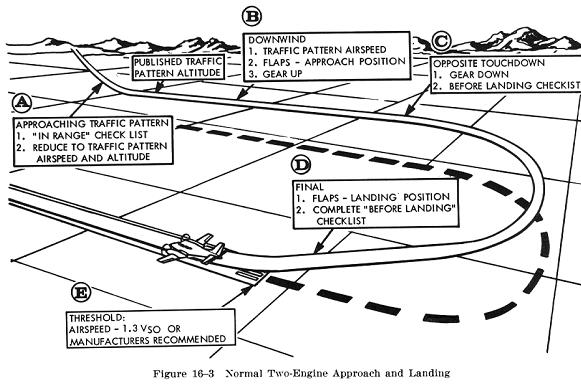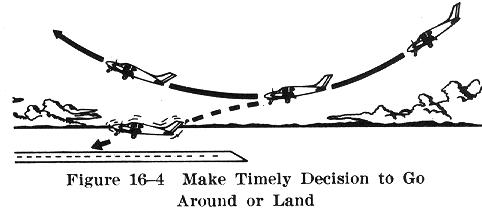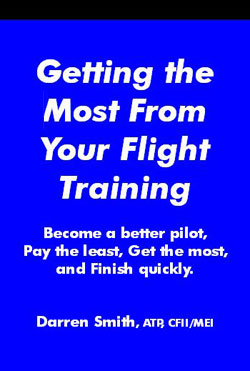
 |
||
| Home | Login | Schedule | Pilot Store | 7-Day IFR | IFR Adventure | Trip Reports | Blog | Fun | Reviews | Weather | Articles | Links | Helicopter | Download | Bio | ||
Site MapSubscribePrivate Pilot Learn to Fly Instrument Pilot 7 day IFR Rating IFR Adventure Commercial Pilot Multi-Engine Pilot Human Factors/CRM Recurrent Training Ground Schools Articles Privacy Policy About Me Keyword:  |
7. Stalls and Flight Maneuvers at Critically Slow Speeds. As with single engine airplanes, the pilot should be familiar with the stall and minimum controllability characteristics of the multiengine airplane being flown. The larger and heavier airplanes have slower responses in stall recoveries and in maneuvering at critically slow speeds due to their greater weight. The practice of stalls in multiengine airplanes, therefore, should be performed at altitudes sufficiently high to allow recoveries to be completed at least 3,000 feet above the ground. It usually is inadvisable to execute full stalls in multiengine airplanes because of their relatively high wing loading; therefore, practice should be limited to approaches to stalls (imminent), with recoveries initiated at the first physical indication of the stall. As a general rule, however, full stalls in multiengine airplanes are not necessarily violent or hazardous. The pilot should become familiar with imminent stalls entered with various flap settings, power settings, and landing gear positions. It should be noted that the extension of the landing gear will cause little difference in the stalling speed, but it will cause a more rapid loss of speed in a stall approach. Power on stalls should be entered with both engines set at approximately 65 percent power. Takeoff power may be used provided the entry speed is not greater than the normal liftoff speed. Stalls in airplanes with relative low power loading using maximum climb power usually result in an excessive nose high attitude and make the recovery more difficult. Because of possible loss of control, stalls with one engine inoperative or at idle power and the other developing effective power are not to be performed during multiengine flight tests nor should they be practiced by applicants for multiengine class ratings. The same techniques used in recognition and avoidance of stalls of single engine airplanes apply to stalls in multiengine airplanes. The transitioning pilot must become familiar with the characteristics which announce an approaching or imminent stall, the indicated airspeed at which it occurs, and the proper technique for recovery. The increase in pitch attitude for stall entries should be gradual to prevent momentum from carrying the airplane into an abnormally high nose up attitude with a resulting deceptively low indicated airspeed at the time the stall occurs. It is recommended that the rate of pitch change result in a 1 knot per second decrease in airspeed. In all stall recoveries the controls should be used very smoothly, avoiding abrupt pitch changes. Because of high gyroscopic stresses, this is particularly true in airplanes with extensions between the engines and propellers. Smooth control manipulation is particularly a requisite of flight at minimum or critically slow airspeeds. As with all piloting operations, a smooth technique permits the development of a more sensitive feel of the controls with a keener sense of stall anticipation. Flight at minimum or critically slow airspeeds gives the pilot an understanding of the relationship between the attitude of an airplane, the feel of its control reactions and the approach to an actual stall. Generally, the technique of flight at minimum airspeeds is the same in a multiengine airplane as it is in a single engine airplane. Because of the additional equipment in the multiengine airplane, the transitioning pilot has more to do and observe, and the usually slower control reaction requires better anticipation. Care must be taken to observe engine temperature indications for possible overheating, and to make necessary power adjustments smoothly on both engines at the same time. 8. Approaches and Landings. Multiengine airplanes characteristically have steeper gliding angles because of their relatively high wing loading, and greater drag of wing flaps and landing gear when extended. For this reason, power is normally used throughout the approach to shallow the approach angle and prevent a high rate of sink.  The accepted technique for making stabilized landing approaches is to reduce the power to a predetermined setting during the arrival descent so the appropriate landing gear extension speed will be attained in level flight as the downwind leg of the approach pattern is entered (Fig. 16-3). With this power setting, the extension of the landing gear (when the airplane is on the downwind leg opposite the intended point of touchdown) will further reduce the airspeed to the desired traffic pattern airspeed. The manufacturer's recommended speed should be used throughout the pattern. When practicable, however, the speed should be compatible with other air traffic in the traffic pattern. When within the maximum speed for flap extension, the flaps may be partially lowered if desired, to aid in reducing the airspeed to traffic pattern speed. The angle of bank normally should not exceed 30 degrees while turning onto the legs of the traffic pattern. The prelanding checklist should be completed by the time the airplane is on base leg so that the pilot may direct full attention to the approach and landing. In a power approach, the airplane should descend at a stabilized rate, allowing the pilot to plan and control the approach path to the point of touchdown. Further extension of the flaps and slight adjustment of power and pitch should be accomplished as necessary to establish and maintain a stabilized approach path. Power and pitch changes during approaches should in all cases be smooth and gradual. The airspeed of the final approach should be as recommended by the manufacturer; if a recommended speed is not furnished, the airspeed should be not less than the engine out best rate of climb speed (Vyse) until the landing is assured, because that is the minimum speed at which a single engine go-around can be made if necessary. IN NO CASE SHOULD THE APPROACH SPEED BE LESS THAN THE CRITICAL ENGINE OUT MINIMUM CONTROL SPEED. If an engine should fail suddenly and it is necessary to make a go-around from a final approach at less than that speed, a catastrophic loss of control could occur. As a rule of thumb, after the wing flaps are extended the final approach speed should be gradually reduced to 1.3 times the power off stalling speed (1.3 Vs0). The roundout or flare should be started at sufficient altitude to allow a smooth transition from the approach to the landing attitude. The touchdown should be smooth, with the airplane touching down on the main wheels and the airplane in a tail low attitude, with or without power as desired. The actual attitude at touchdown is very little different in nosewheel and tailwheel type airplanes. Although airplanes with nosewheels should touch down in a tail low attitude, it should not be so low as to drag the tail on the runway. On the other hand, since the nosewheel is not designed to absorb the impact of the full weight of the airplane, level or nose low attitudes must be avoided. Directional control on the rollout should be accomplished primarily with the rudder and the steerable nosewheel, with discrete use of the brakes applied only as necessary from crosswinds or other factors. 9. Crosswind Landings. Crosswind landing technique in multiengine airplanes is very little different from that required in single engine airplanes. The only significant difference lies in the fact that because of the greater weight, more positive drift correction must be maintained before the touchdown. It should be remembered that FAA requires that most airplanes have satisfactory control capabilities when landing in a direct crosswind of not more than 20 percent of the stall speed (0.2 Vs0). Thus, an airplane with a power off stalling speed of 60 knots has been designed for a maximum direct crosswind of 12 knots (0.2 x 60) on landings. Though skillful pilots may successfully land in much stronger winds, poor pilot technique is apt to cause serious damage in even more gentle winds. Some light and medium multiengine airplanes have demonstrated satisfactory control with crosswind components greater than 0.2 Vs0. If this has been done it will be noted in the Pilot's Operating Handbook under operations limitations. The two basic methods of making crosswind landings, the slipping approach (wing low) and the crabbing approach may be combined. These are discussed in the chapter on Approaches and Landings. The essential factor in all crosswind landing procedures is touching down without drift, with the heading of the airplane parallel to its direction of motion. This will result in minimum side loads on the landing gear. 10. Go-Around Procedure. The complexity of modern multiengine airplanes makes a knowledge of and proficiency in emergency go-around procedures particularly essential for safe piloting. The emergency go-around during a landing approach is inherently critical because it is usually initiated at a very low altitude and airspeed with the airplane's configuration and trim adjustments set for landing.  Unless absolutely necessary, the decision to go around should not be delayed to the point where the airplane is ready to touch down (Fig. 16-4). The more altitude and time available to apply power, establish a climb, retrim, and set up a go-around configuration, the easier and safer the maneuver becomes. When the pilot has decided to go around, immediate action should be taken without hesitation, while maintaining positive control and accurately following the manufacturer's recommended procedures. Go-around procedures vary with different airplanes, depending on their weight, flight characteristics, flap and retractable gear systems, and flight performance. Specific procedures must be learned by the transitioning pilot from the Pilot's Operating Handbook, which should always be available in the cockpit. There are several general go-around procedures which apply to most airplanes, and are worth pointing out: a. When the decision to go around is reached, takeoff power should be applied immediately and the descent stopped by adjusting the pitch attitude to avoid further loss of altitude. b. The flaps should be retracted only in accordance with the procedure prescribed in the airplane's operating manual. Usually this will require the flaps to be positioned as for takeoff. c. After a positive rate of climb is established the landing gear should be retracted, best rate of climb airspeed obtained and maintained, and the airplane trimmed for this climb. The procedure for a normal takeoff climb should then be followed. The basic requirements of a successful go-around, then, are the prompt arrest of the descent, and the attainment and maintenance of the best rate of climb airspeed. At any time the airspeed is faster than the flaps up stalling speed, the flaps may be retracted completely without losing altitude if simultaneously the angle of attack is increased sufficiently. At critically slow airspeeds, however, retracting the flaps prematurely or suddenly can cause a stall or an unanticipated loss of altitude. Rapid or premature retraction of the flaps should be avoided on go-arounds, especially when close to the ground, because of the careful attention and exercise of precise pilot technique necessary to prevent a sudden loss of altitude. It generally will be found that retracting the flaps only halfway or to the specified approach setting decreases the drag a relatively greater amount than it decreases the lift. The FAA approved Airplane Flight Manual or Pilot's Operating Handbook should be consulted regarding landing gear and flap retraction procedures because in some installations simultaneous retraction of the gear and flaps may increase the flap retraction time, and full flaps create more drag than the extended landing gear. <<Previous: Page 1 Your Thoughts... |

|
| Home | Login | Schedule | Pilot Store | 7-Day IFR | IFR Adventure | Trip Reports | Blog | Fun | Reviews | Weather | Articles | Links | Helicopter | Download | Bio |
| All content is Copyright 2002-2010 by Darren Smith. All rights reserved. Subject to change without notice. This website is not a substitute for competent flight instruction. There are no representations or warranties of any kind made pertaining to this service/information and any warranty, express or implied, is excluded and disclaimed including but not limited to the implied warranties of merchantability and/or fitness for a particular purpose. Under no circumstances or theories of liability, including without limitation the negligence of any party, contract, warranty or strict liability in tort, shall the website creator/author or any of its affiliated or related organizations be liable for any direct, indirect, incidental, special, consequential or punitive damages as a result of the use of, or the inability to use, any information provided through this service even if advised of the possibility of such damages. For more information about this website, including the privacy policy, see about this website. |